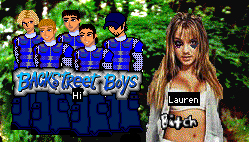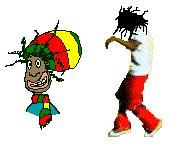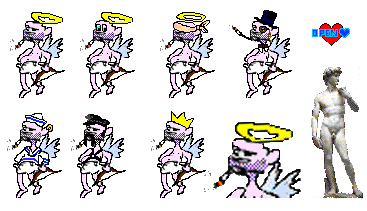3. Can You See My Touch?
How do people inhabit the virtual space? How are they able to communicate emotions, identities, and body?
3.1 Set Dressing
The Palace is not technically the most developed but it has some points that lack from the many other avatar worlds: in The Palace the user can pretty easily construct her avatar completely herself in comparison of the readymade head/body/limb sets that are often offered in many of the other technologies. This leaves much room for creative self-expression of body and identity. Users can also position themselves both horizontally and vertically. Sometimes this is done in a way that avatar seems to "blend into" the space creating the sense of it actually inhabiting it like physical space. A swimming avatar is in the water, the sitting one takes the sofa and someone is hanging from the roof and the one whose body is cut under the waist is located in the bottom of the window. Despite of this "set dressing" (Picture 3.) the dynamics of the group is very easy to recognize in PalaceSpace just by observing who stays close to whom, who is above others etc. Some of the rooms are designed in a way that the image supports certain kind of positioning and dynamics and much of the popularity of the room also depends on its abilities to meet the creative and social needs of the users. John Suler has observed the positioning of the avatars in Palace spaces:
The patterns of where people place their avatars follow familiar principles in group dynamics theory. Dyads, triads, isolates, alliances, leadership patterns, and fluctuations in group cohesion are clearly visible. [...] From a social psychological perspective, this flexibility in creating new graphical spaces is resulting in the formation of separate communities and subgroups within the Palace "universe." Issues of immigration, territory, recruitment, intergroup cooperation and competition, loyalty and betrayal are all beginning to surface in this universe. (Suler 1999)

Picture 3. Set Dressing and gang avatars.
The Palace gods often position themselves little bit above of other persons in room. A couple with romantic attachment stay close to each other and they often wear similar avatars or indeed a couple avatars like Lady and the Tramp, Mulder and Scully, Pepe Le Pew and Penelope etc. Some images are chosen by the position of character so that they are hugging or leaning at each other. In a room full of people many often move close to one they want to talk to. Sometimes two users share one avatar, which then usually is image with two humans or other characters in it.
Personal space is a concept in digital space as well as in the meat space. Being very close to someone can been seen either as an act of intimacy or as an act of invasion of that space - an aggressive expression. When I take my bots online I usually set them, especially cupid, on the upper part of the room. However in the course of action they might change their place in the room. Wizards and gods [9.] of Lady Luck however often move cupid back up, if he gets too down. Maybe the god of love needs to be above others?
3.2 Avatars
Even though the artistic freedom to create avatars in The Palace technology is limited only by the regulations that some of the communities have for example relating to nudity, used image types can be framed in few categories. Human figures are by far the most popular ones, ranging from pictures of models and movie stars to drawn humanlike characters. Animals are quite popular as well, but mostly I have seen only kittens, puppies and popular cartoon animals. Much more rare is to see someone wearing an object of some sorts. However, I have seen are few toilet seats, teddy bears and couches around (if you are a couch somebody might sit on you).
There are many reasons to end up wearing some particular avatar. It can reflect some aspects of individual's personality and lifestyle, mood, interests, social role, attitudes or values (Suler 1997b). Whether the reasons are psychological, social or communicative, most of the users have a set of different kind of avatars that they change from time to time, perhaps as (subconscious) reflection of their mood or as a reaction to events or avatars of others in a room.

Picture 4. Hi probably likes Backstreet Boys, whereas Lauren's attitude towards Britney Spears seems to be more ambiguous.
I was in a café and out of the blue said to my friend: I must be having an identity crisis because I cannot wear the same avatar one minute longer. It was a joke. But it was true. Whether a new haircut and new clothes that are attached to an identity crisis are just a myth or actually proven fact, the "changing self" seems to affect to its representations both in virtual reality and meatspace. I have not used avatars with long hair since I cut my own hair short.
Once in The Palace I met a woman that had just lost her lover both on- and offline (see chapter 4.1.1). She was not wearing avatar at all. She was just a nametag and she located herself to the black part of the background so all you could see about her was her name. In palace, if you do not wear an avatar your presentation is an "smiley face" being invisible takes some effort. Maybe she was wearing a mourning dress or maybe her virtual identity was so much defined by the other that she was not able to use her normal visual representation. Another woman that tragically broke up with her on-line boyfriend (see chapter 4.1.2) stated out loud that she could not wear her old avatars anymore. Also amongst The Palace users is a young woman that was always wearing a variety of Xena: Warrior Princess -avatars but in each image Xena was badly beaten to bruises, bleeding or even dead. Later on we found out that she has a history with a violent boyfriend that used to beat her up. After that some members of the community found it awkward to relate to her avatars. There are many similar examples of avatar reflecting something ongoing in one's life. Sherry Turkle for instance talks about these kinds of cases in her book "Life on the Screen". Sometimes it is good for the psyche to process these issues in virtual but sometimes it is something that maintains the trauma rather than heals it (Turkle 1995).
I was in a café for a change, talking to a good friend of mine. We were enjoying our usual semi-intellectual conversation. She leaned her left arm casually on her head, fingers extended so that her burning cigarette wouldn't touch her hair. Suddenly I noticed that I was exactly in the same position as she was.
When two people are communicating, the weaker party catches the mood of the stronger one. The density of emotional connection can be seen from the quantity of the similar movements of the people when they are talking to each other. The bodily synchronization applies also for example in classroom situations: the more a teacher and a student imitate each other's movements, the more relaxed and interested they are in a educational situation. (Coleman 1999: 150)
Many of the experienced users of The Palace seem to be rather sensitive to making conclusions about the avatars of other's. If some usually is wearing say a funny relaxed image and then suddenly pulls out a bloody decapitated head, her online friends do notice and start questioning for the reasons. People also sometimes react to the avatar of other by putting on an avatar that relates to same idea or mood. For example my sleeping avatar (Picture 5.) attracts others to cuddle up with me. Somebody wearing animated dancing avatar may very well provoke the whole crowd to dancing mood.

Picture 5. Sleeping tight
|
Picture of sleeping Xena: Warrior Princess is one of the avatars I often use. Subconsciously I often put it on when I am tired for real. And since it obviously attracts some of my virtual friends, I might probably wear it just to get some sympathy and closeness.
|
I have a small confession to make. More often than not, I get disappointed when a virtual acquaintance shows me a real picture of him. Not that I imagined him to have a striking resemblance with Johnny Depp, but still.... He could not be further from Johnny Depp!
Maybe here is the reason why people tend to like each other in virtual space: they seem all so pretty and witty. Is it a good thing or a bad thing? Sandy Stone has researched telephone sex services and she points out that there are benefits of having a bad line. What she calls as "low bandwidth" effects conversations in a way that the gaps of the information get filled by ideal fantasy (Stone 1996: 93). The same thing happens with the "low resolution" of CMC. A fantasy does replace things that are not known about the company. In The Palace, showing a real picture of oneself is an act of trust and usually it is done after a longer term of acquaintanceship. CMC can be liberating for example to some young girls who would like to talk with boys but are too shy and may feel insecure about their looks.

Picture 6. Avatar adds meaning to message.
As the picture above is trying to demonstrate, an avatar adds a lot of meaning to the textual message. Of course the preceding conversation is crucial for the meaning that receivers are able to form. But despite of the fact that they know better, people attach the look and characteristics of an avatar to its user. Probably the effect is not that big when the same image stays on all the time. One does not change avatars like expressions on face. But nevertheless avatars add something to the general impression and the characteristics of the user, even when others know what she looks like in real life. Most of the users in The Palace have a small set of their favorite avatars and mainly stick to them. This notion of facial expressions is observed also by Judith S. Donath. She points out that expressions have many social roles from communicating emotions to communicating cues in turn-taking and attention (Donath 1997). I think that some of the users in The Palace change their avatars as reactions to emotional impressions they get from the conversation with others. And they read a lot of emotions and characteristics on the basis of avatar or changing of an avatar.
My own experience of wearing avatars is that while I am mainly using images of one of the favorite television characters of mine, the particular facial expressions and postures of hers I (subconsciously) choose to wear in some particular moment, highly depend on the emotional state I happen to be in. However if I for some reason have ended up wearing something else, my behavior is substantially affected. For example one evening many of the users were wearing well-known cartoon characters as avatars. I ended up wearing a "Pepe Le Pew "-avatar, the ultra-confident skunk-stud chasing every cute kitten around, and suddenly I was heavily flirting with everybody. This particular case can be interpreted as a mere costume party behavior and hence harmless but nevertheless avatars must be taken seriously.
3.3 Bots' Avatars
MegBot's avatar is very well chosen. It is an image of a funny character in a TV-show [10.]. The expression on her face is a little bit goofy and hence reflects of sense of humor and/or personality that does not apply to every rule of social standards. That is why we can ask insulting questions from her and get away with it. And that is why it is somehow more understandable that she laughs with us just after we have been mean to her. I used this notion when I designed Laban's avatar (Picture 7.) which is also a simple image of a face with strong emotional expression.

Picture 7. Laban's avatars
|
Laban uses mostly the avatar on the left. On some rare occasions he switches to animated headbanger avatar. It is just a little humorous trick.
|
The more a representation of a face moves towards an iconic symbol of a face (two dots as eyes and a line as a mouth) the more a viewer needs to read it (McCould 1994). Caricature in comparison to photograph tells just some main characteristics of the persona it represents. The rest, I reckon, the user imagines herself in order to build a satisfactory conception of the person. My theory with Laban's face was that if he keeps his wide grin on all the time it supports the notion of "jolly idiot" on which I based his dialogue. Nothing makes him sad and his face as well as his speech should manifest it.

Picture 8. Cupid's set of avatars
Cupid has a total of ten different avatars (picture 8.). He changes his look mostly with imaginary parameters of romance, love, flirting and sex. Small visual tricks add a lot to his characteristics. Some of the keywords and cupid's lines are designed to some particular avatar, which he keeps wearing until another keywords triggers a new look. Parts of his dialogue he just says with the avatar he happens to be wearing, which adds a level of different possible meanings with the element of randomness and surprise: the same line with a different avatar might create a different meaning.
3.4 Props
In The Palace it is also possible to design props that users can either wear or drop on the room. Props can be powerful communicative elements. They can be objects like flowers, beer bottles, hearts, balloons and party hats, which are used for example as "gifts" to others. Props are often textual messages, signs that are mostly used as a joke. Sometimes they are like graffiti with political message or information to somebody or everybody, for example "Refuse, Resist Wizards" or "Mickey was here". Bots get often surrounded by props that users have given to them, either as expression of love or hate.

Picture 9. Cupid has received both loving and aggressive mementos.
Cupid has lot of props that he uses to further his agenda to get people to form romantic liaisons. For example he gives a heart with a keyhole to somebody and a key to somebody else. He draws lines from one to another and shoots arrows. Laban's props confirm the stereotypical notion attached to Rastafarians: he smokes joints and sends "weedkisses" to people.
3.5 Gender On-line
I have never been more aware of my female gender than in a costume party where I was dressed as a cowboy, with a fake moustache, gun in my belt and a sock stuffed in my pants.
Question: Can you guess which one of the female avatars below is a male in real life?

Picture 10. Rank of females with attitude.
Answer: He is LuxyFan, the one with most "feminine" avatar of cute young woman with long red hair.
A young man likes a beautiful and talented singer called Jennifer. So this man uses JenniferiX as his nickname and wears Jennifer's picture as his avatar. He is not a gender swapper. He is just a man who likes beautiful women. That seems pretty normal to me.
Instead of asking why men pretend to be women in cyberspace, why not turn the question upside down: why does somebody go to cyberspace as himself when he could be anything he likes to be? Actually, he could pretend to be anything he likes to be. Maybe, just maybe, the sensitivity towards gender representations is only a field that researchers like to dissect. It is not a field that really bothers the majority of the users in chat rooms. They just go to a chat room to have fun or to get some information for instance. Some of them cannot or want not be anything else than themselves. The changes in their character happens at most in an emotional scale: "tired me", "happy me" and "me in the party mood" etc. They do not think about what gender to wear and how. Some just end up having an avatar & name combination that is (at least in cultural stereotypical way) attached to either one of dominant genders. Some end up having more ambiguous gender representation but sometimes that is just an accident. The average user, I think, represent his/her own gender without even considering the alternative. Other than human avatars are also attached with gender, for example kittens are usually considered feminine.
It does happen that someone is mistaken to be of the opposite gender that s/he is. If one's own gender is misinterpreted it does not seem to bother one too much; rather it is just funny. After all, people are used to all sorts of misunderstandings in cyberspace. Some play along with false assumptions about their gender and some correct the mistake immediately. Sometimes playing along with the "wrong" gender for a while is a test to see if the gender matters to others once the truth is out. On the other hand, mistaking other's gender may cause a feeling of shame. Some feel ashamed because they caught themselves using the same old cultural stereotypes: defining someone's gender on the basis of his/her profession for instance.
If someone produces a meaning in cyberspace and I interpret it in a "wrong way", who is to blame? Or is it even such a bad thing in cyberspace? It can be something in the (contemporary) interface that does not make it possible to produce all the nuances of face-to-face communication. It can be a personal bias that causes falling into the traps of using stereotypical assumptions and established cultural codes. That can happen easily in multicultural mediated space that has to discursively establish its own cultural codes.
A man who portraits himself as a woman in cyberspace is not a woman, he is a man who pretends to be a woman. Others may think that he is she or may not. They may or may not treat him as a woman regardless. If his female "masquerade" is successful, he might think that he knows what it is like to be a woman. I think though that if he learns something, he is more likely to understand something about the things in him that makes him a male. When cupid flirts with males the response he most often gets is "are you gay?" rather than for example "do you think I am a woman?" Yet many men seem to enjoy his & Laban's company. In fact, biggest fans of both bots have been male. Loving a bot does not necessarily have anything to do with the gender of his character. Bots are gender-blind and because both of my bots do flirt and make suggestions of sexual nature, they could be called bisexuals as well. Cupid tries to match people together regardless of their gender. Often when he suggest romantic involvement for two heterosexual people with same gender, his comments get ignored. But when he manages to match suitable two people, his suggestions is taken upon as an encouragement to play with the idea of that particular romance in the air.
I tend to agree with Alberto Melucci's notion of the difference of the others: Of all instances of difference, two are inevitable and affect us more than others: age and gender. They represent fundamental difference, permanent otherness, which serves as a metaphor for any other difference. Being young and being old, being male and being female, are the poles of an irreducible difference, which can teach us how to meet the challenge of encounter. Difference to others makes us confront ourselves, with our limit and with our uniqueness. And difference forces us to seek something in common - to build a common language and rules of exchange. (Melucci 1996: 101-102)
Here might very well lie one of the lures of computer mediated communication: gender and age are matters of communication. That is, you can (try to) hide your true age and gender, you can even (try to) become someone with no age nor gender. Sooner or later though someone gets curious and asks about them. Then you can choose to lie because no one can see from your gray hair that you have reached puberty decades ago and your thick beard is really not so very feminine. You can even pretend to be an automaton - a chatterbot.
Race, as well, has become a matter of communication in cyberspace. But in fact it seems that is not communicated at all. Rather it seems that despite the cultural multiplicity of the users in The Palace, almost all represent themselves as white (by wearing white avatars). Maybe it is a bias of a white North-European to automatically presume that others too have a white skin, especially since there have been numerous writings manifesting that computers and internet are a privilege of white, rich people that people of color really cannot afford to use. Still, when I logged on with a web camera for the first time: there it was, the wide range of all beautiful skin colors.
Identity as a cultural-social construction is also defined by e.g. age, gender and race. In virtual environment identity is a construction of discursive elements. Avatar and name alone establish the basis of virtual identity and the way that others perceive its user as an individual and in relation to a group. As Donna Haraway points out, technologies should be viewed as instruments for enforcing meanings (Haraway 1991: 164). For example, since one is forced to wear some kind of avatar the possibilities to choose from do have importance. What kind of meanings do such avatar worlds enforce where the user has a very limited readymade head, body and limb sets to choose from? This design solution forces all users to few typical body structures and to either one of the dominant genders. Because she makes such an important note for designers to consider, I quote Judith Donath:
In the real world, the built environment is only a small part of the environment as a whole. In the virtual world, the built environment is everything: it is a wholly mediated and synthetic world. The participants in a virtual world are wholly dependent upon the tools supplied by the creators of the space to communicate. The choices made by the designer of a virtual environment thus greatly influence and constrain the means of communication and the ways in which a cultural vocabulary develops. (Donath 1997)
She is not talking just about avatars or identity but also about everything else in digital communication environments. Still, as a part of the means of communication and cultural vocabulary is an ability to represent one's identity. Design should offer tools to communicate it to others.

Picture 11. Korn Dolls
Once in Xena: Warrior Palace everybody got suddenly enthusiastic about "Korn doll" avatars (Picture 11.). Each made his/her own animated avatar with slight modifications. Newcomers arriving at the gate got their own images and joined in the play. Wearing of similar avatars creates the sense of togetherness or a gang. Small differences in the details of each avatar then again allow each to have a personal unity in the dialogue with others.
Alberto Melucci calls for a new analytical frame where identity should be conceived as relational field comprising both freedoms and constraints: "In the contemporary systems, the site where the meaning of action is constructed shifts to the individual, who thus becomes a social actor in the true sense of the word" (Melucci 1996: 47). When users struggle to produce their identity in cyberspace, one thing essential is a difference to others. Without it a meaning could not exist (Hall 1997: 235). Identity needs intersubjective recognition: our personal unity, which is produced and maintained by self-identification, rests on our membership in a group and on our ability to locate ourselves within a system of relations. (Melucci 1996: 29) Identity is established as a member of a community (Donath 1997).






